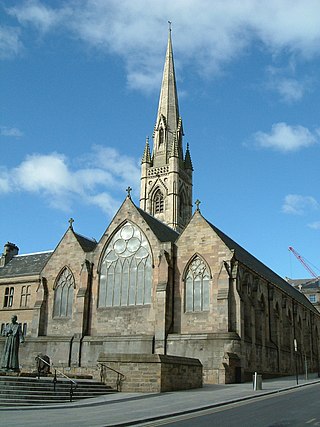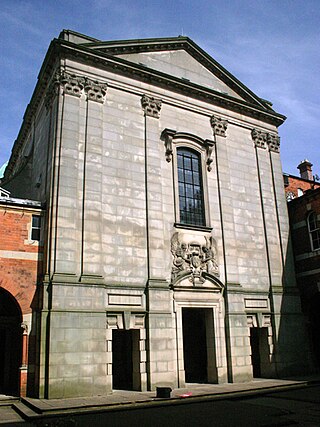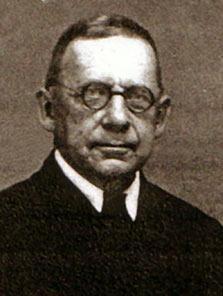
King Edward's School (KES) is an independent day school for boys in the British public school tradition, located in Edgbaston, Birmingham. Founded by King Edward VI in 1552, it is part of the Foundation of the Schools of King Edward VI. It is a member of the Headmasters' and Headmistresses' Conference. As of 2021, King Edward's School was ranked as one of the top 10 International Baccalaureate schools in the United Kingdom and amongst the top 25 in the world. In 2020, the Tatler School Guide described the school as "academically elite", saying that it is "in the process of upping its already sky-high intellectual ante [...] with top-of-the-range sporting facilities and a raft of extracurricular activities [...] it comes as no surprise that leavers head off to a shining constellation of universities".

Edgbaston is an affluent suburban area of central Birmingham, England, historically in Warwickshire, and curved around the southwest of the city centre.

St Philip Neri Church Liverpool is home to the Roman Catholic chaplaincy to the universities in Liverpool. It features a Byzantine inspired design by PS Gilby and was built between 1914 and 1920. There are exterior friezes depicting the Last Supper and of Our Lady and the Child Jesus inscribed with the two titles given to Our Lady at the Council of Ephesus in 431 AD, i.e. 'Deipara' and 'Theotokos' over the door onto Catherine Street. There is also a large stone inscribed in Latin set in the wall bearing the name of Thomas (Whiteside), Archbishop of Liverpool 8 Oct 1916 which dates from the time the church was constructed. The parish grew from the school named 'The Institute' which opened in 1853 in nearby Hope Street. It was visited by the founder of the English Oratorians (Cardinal) John Henry Newman of The Oratory of St Philip Neri in Edgbaston, Birmingham. The parish and later the church were named after Saint Philip Neri in honour of Newman since Philip Neri had founded the original Oratory church in Rome. Parish registers of the church dating as far back as 1864 can be inspected at the Liverpool Record Office.

The Confederation of Oratories of Saint Philip Neri, abbreviated CO and commonly known as the Oratorians, is a Catholic society of apostolic life of Pontifical Right for men who live together in a community bound together by no formal vows but only with the bond of charity.

The Cathedral Church of St Mary is a Catholic cathedral in Newcastle upon Tyne, Tyne and Wear, England. It is the mother church of the Diocese of Hexham and Newcastle and seat of the Bishop of Hexham and Newcastle. The cathedral, situated on Clayton Street, was designed by Augustus Welby Pugin and built between 1842 and 1844. The cathedral is a grade I listed building and a fine example of the Gothic Revival style of architecture championed by Pugin.

Five Ways is an area of Central Birmingham, England. It takes its name from a major road junction, now a busy roundabout to the south-west of the city centre which lies at the outward end of Broad Street, where the Birmingham Middle ring road crosses the start of the A456.

The Oratory School is an HMC co-educational private Roman Catholic boarding and day school for pupils aged 11–18 located in Woodcote, 6 miles (9.7 km) north-west of Reading. Founded in 1859 by Saint John Henry Newman, The Oratory has historical ties to the Birmingham Oratory and the London Oratory School. Although a separate entity from the nearby Oratory Preparatory School, it shares a common history. Newman founded the school with the intention of providing boys with a Roman Catholic alternative to Eton College. Until 2020, when it first admitted girls, it was the only boys’ Roman Catholic public school left in the United Kingdom. According to the Good Schools Guide, the school is “an active choice for families looking for a small, nurturing environment... Parents tell us - ‘it’s like a new school'; ‘we all want to be on board... With excellent leadership and now girls on board, too, The Oratory seems to be thriving."

The Birmingham Oratory is a Roman Catholic religious community of the Congregation of the Oratory of St. Philip Neri, located in the Edgbaston area of Birmingham. The community was founded in 1849 by St. John Henry Newman, Cong.Orat., the first house of that congregation in England.

Bearwood is the southern part of Smethwick, Sandwell, West Midlands, England, and north of the A456 Hagley Road. Bearwood Hill was the original name of the High Street from Smethwick Council House to Windmill Lane. The border at the Shireland Brook where Portland Road (Edgbaston) becomes Shireland Road (Sandwell) is signed "Bearwood".
The Tolkien family is an English family of German descent whose best-known member is J. R. R. Tolkien, Oxford academic and author of the fantasy books The Hobbit, The Lord of the Rings and The Silmarillion.

Julius Alfred Chatwin FRIBA, ARBS, FSAScot was a British architect. He was involved with the building and modification of many churches in Birmingham, and practised both Neo-Gothic and Neo-Classical styles. His designs always included all of the carvings and internal fittings.

The Church of St Augustine of Hippo in Lyttelton Road, Edgbaston, Birmingham, England, is a parish church in the Church of England.

Edward Caswall, CO, was an Anglican clergyman and hymn writer who converted to Catholicism and became an Oratorian priest. His more notable hymns include: "Alleluia! Alleluia! Let the Holy Anthem Rise"; "Come, Holy Ghost"; and "Ye Sons and Daughters of the Lord".
This article is intended to show a timeline of events in the History of Birmingham, England, with a particular focus on the events, people or places that are covered in Wikipedia articles.

Edgbaston High School for Girls is a private day school for girls aged 2+1⁄2 to 18 in the Edgbaston area of Birmingham, England.

The literary tradition of Birmingham originally grew out of the culture of religious puritanism that developed in the town in the 16th and 17th centuries. Birmingham's location away from established centres of power, its dynamic merchant-based economy and its weak aristocracy gave it a reputation as a place where loyalty to the established power structures of church and feudal state were weak, and saw it emerge as a haven for free-thinkers and radicals, encouraging the birth of a vibrant culture of writing, printing and publishing.

St Anne's Church is a Roman Catholic Parish church on Alcester Street in Digbeth, part of the city centre of Birmingham. It was founded by Saint John Henry Newman in 1849. It was moved to a new building in 1884 designed by London architects Albert Vicars and John O'Neill, who also designed St Hugh's Church in Lincoln, and helped design St Peter's Cathedral in Belfast.
Anne Hope (1809–1887), née Anne Fulton, was an English historian.
John Francis Reuel Tolkien was an English Roman-Catholic priest and the eldest son of J. R. R. Tolkien. He served as a parish priest in Oxford, Coventry, Birmingham, and Stoke-on-Trent. He was also a chaplain at the University College of North Staffordshire and to two schools, as well as a governor of St Joseph's College. During his lifetime and after his death, there were a number of allegations of child sexual abuse against him: he was questioned by the police but never charged or convicted.

Francis Xavier Morgan, C. O. was a Catholic priest of the Oratory of Saint Philip Neri, who had Spanish and British dual citizenship. He served for most of his priesthood at the Birmingham Oratory in Edgbaston. Decades after his death, Morgan has become famous as the teacher, legal guardian, and father figure to the fantasy author J. R. R. Tolkien.
















